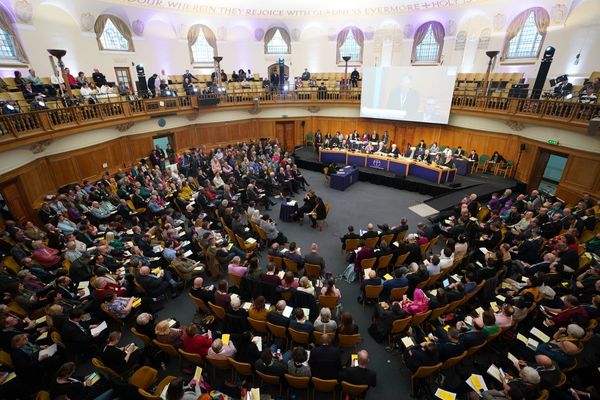
Like death follows life, whispers of recession have been stalking central banks and policymakers for months. The global outlook was said to have “darkened significantly” in July. A downturn within 12 months was “effectively certain” as of October. And in January many economists believed the underlying frailties in the world economy were beginning to crack.
In reality, none of this was or is surprising. The axis of history shows happy endings are elusive when ferocious interest rate rises are relied on to tame sky-high inflation, with brutal recessions — or what economists call “hard landings’ — close to a given in such circumstances.
And yet for all that, none of the gloomy warnings have matched the reality on the ground — at least not until now.
In recent weeks, a mini banking crisis has swept the United States, fomenting concern about a potential forest fire of global economic pain. The unrelated collapse of Credit Suisse on the other side of the Atlantic at the weekend has meanwhile fed perceptions a worldwide recession is waiting in the wings, notwithstanding the bank’s singular history of scandal.
And, adding to the stormy horizon, the unprecedented emergency steps taken by regulators and central banks to restore and ensure stability in the financial system in the past week appear to have spooked an already spooked sector.
The vibe of things, in other words, has within a matter of days gone from pretty crummy to painfully grim. Which, in an environment where vibes tend to count for everything, may or may not give life to those relentless whispers of a global recession.
So, who’s to blame, how did we arrive at this juncture, what will it mean for Australia and, in particular, how will it impact the Reserve Bank’s fight against inflation?
What triggered the crisis?
The short answer is a little-known Californian lender for start-ups and tech firms by the name of Silicon Valley Bank (SVB), whose collapse two Fridays ago not only marked the second-largest bank failure in US history but gave rise to the largest bank run ever witnessed in the country. On one day alone, the bank’s customers withdrew US$42 billion over 10 consecutive hours. That’s more than US$1 million a second.
So far, autopsies on SVB’s demise are a little mixed, but most commentators say it’s down to a combination of mismanagement, lax regulation (due to some Trump-era reforms), poor auditing and some powerful investors crying fire in a crowded theatre on Twitter.
The overriding problem, however, was that the bank had invested more than half its assets in what is — when interest rates are low — one of the safest bets in town: simple government-backed bonds. As inflation started to climb and the Federal Reserve raised interest rates, the value of those bonds naturally collapsed, setting fire to SVB’s investment portfolio and all but guaranteeing a bank run.
The ensuing panic proved contagious, with SVB’s collapse quickly followed by the crash of New York’s Signature Bank and a deposit run at several other regional banks.
An unprecedented emergency reaction
The response of authorities, in the US and overseas, was as extraordinary as it was swift. To avoid a wider systemic meltdown, the US Treasury swooped in to protect all deposits at SVB and Signature Bank, while the Federal Reserve — that lender of last resort — set up a new line of emergency credit for all banks carrying losses (sparked by the Fed’s higher interest rates) on their bond portfolios.
The sheer scale of the emergency rescue is unmasked by the numbers. In the week before the measures were announced, the extent of the Fed’s emergency lending was sitting at around US$15 billion a week. It’s since risen to US$318 billion a week, far exceeding the US$130 billion required at the beginning of the pandemic and not hugely off the US$437 billion lent at the height of the global financial crisis some 15 years ago.
At the same time, and in an effort to both ease and guard against further financial strain, the Fed and four other leading central banks have also announced a range of coordinated measures to reduce the risk of any impending credit crunch. The so-called swap arrangement, in particular, reveals the Fed holds reservations about its ability to contain the fallout of the turmoil in the banking system.
Will these measures stem the crisis?
That’s the multitrillion-dollar question. Despite all the action, doubt has been cast on the enduring ability of the measures to fully quell or prevent future bank runs witnessed at several smaller and medium-sized banks in recent weeks, even though the banks — for the time being — appear to have stabilised. In addition, the separate $30 billion lifeline thrown to the First Republic Bank from Wall Street does not, contrary to expectations, appear to be staving off the risk of another bank collapse, with the troubled bank now reportedly turning to the Fed for a similar bailout.
And beyond these considerations lies the pointy issue of whether the Fed’s emergency measures will slow lending and give rise to a credit crunch, given the impacted banks are liable to treat most of the funds as short-term borrowings. This, in other words, means tougher lending conditions are almost inevitably on the horizon, spelling yet another round of pain for businesses and households alike.
So, who’s to blame?
In case it’s lost on anyone, the irony of recent events in the US is that the Fed is now rescuing banks from a problem entirely of its own creation. It’s true, of course, executives at SVB could and should have had the wit to protect the bank’s investment arm by hedging against the risk of an interest rate hike. But it’s equally true that the Fed’s decision to rapidly raise interest rates to tame inflation over the past year was the proximate cause of the bank’s crash.
As many have pointed out, the Fed is contending with inflation that is largely the function of supply-side factors, such as the pandemic, natural disasters and war in Ukraine — things, in other words, which manifestly lie outside the influence or control of any central bank.
And so, even if it’s accepted that regulators, politicians and SVB executives all in their own way laid the foundation for SVB’s demise, it was undoubtedly the Fed and the Fed alone which poured the petrol and dropped the match as it waged war against inflation it, for the most part, can’t conceivably influence.
Will Australia raise interest rates again?
Notwithstanding the banking turmoil, the Fed once again cited the stickiness of inflation as it raised interest rates on Wednesday US time while flagging a great deal of uncertainty about whether future hikes remained on the cards. The decision was made despite the Fed’s concession that the banking crisis itself would more than likely tighten lending and cool the economy, thereby adding weight to the prospect of a hard landing.
To some extent this wasn’t surprising. Much like Australia’s Reserve Bank, the Fed subscribes to orthodox monetary thinking which holds the one and only way to tamp down runaway inflation is via higher interest rates.
It bears emphasising, however, that the decision is at odds with concerns the recent banking crisis has proven a cash rate of 6% in a highly leveraged economy like the US is plainly inconsonant with economic and financial stability. The Fed, for its part, framed the SVB crash and subsequent banking turmoil as an aberration, due to the bank’s large share of uninsured deposits (which exacerbated the rapid deposit run) and its unusual investment in long-term bonds.
When asked whether a so-called soft landing (that is, no recession) was still possible in light of the recent crisis, the Fed’s chairman Jerome Powell equivocated. “The question will be how long this period will be sustained,” he said, adding, “there is a pathway … and we’re trying to find it.” In response, the markets fell at the close of late trading, with suggestions the Fed was too dismissive of the implications of the banking crisis.
Back home, comments by Reserve Bank deputy governor Christopher Kent on Monday neither ruled in nor out a further rate rise, though the weight of public opinion supports a pause. But as ever, the decision will turn on a range of factors, including the Fed’s lead and, not least, the Reserve Bank’s shared blind faith in the Peter Pan wisdom of orthodox monetary thinking.
Is a global recession coming?
It’s still too soon to say whether all those whispers of recession will materialise into a force to be reckoned with. But if history is any guide, even the most panglossian of friends would concede the drumbeat of fear is starting to supersede confidence.
In other words: the vibes aren’t great, and with no obvious vibe inflection point in sight, we could all suffer for it. And soon.







